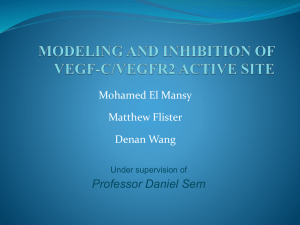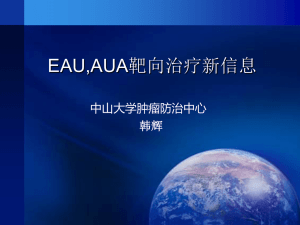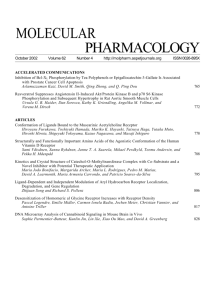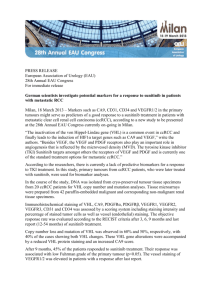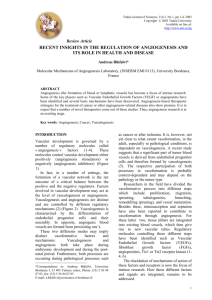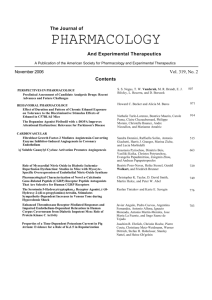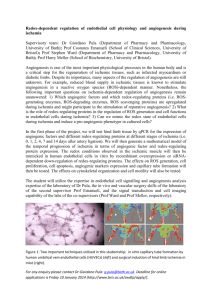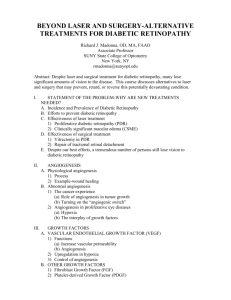136 - Blue Ridge Institute for Medical Research
advertisement
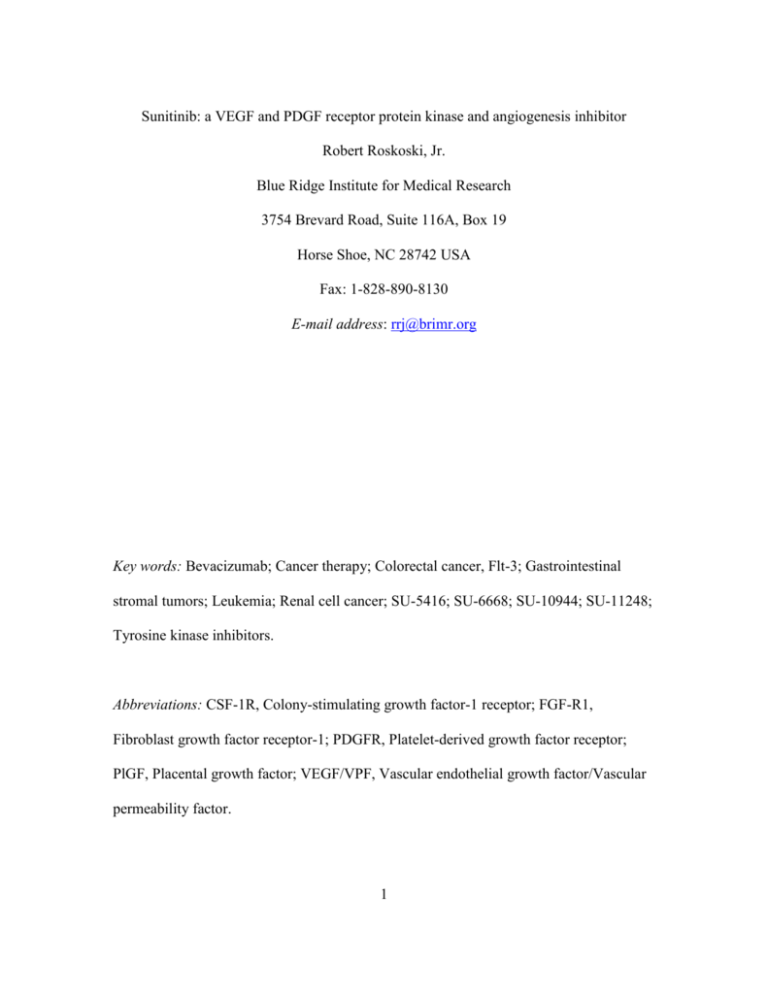
Sunitinib: a VEGF and PDGF receptor protein kinase and angiogenesis inhibitor Robert Roskoski, Jr. Blue Ridge Institute for Medical Research 3754 Brevard Road, Suite 116A, Box 19 Horse Shoe, NC 28742 USA Fax: 1-828-890-8130 E-mail address: rrj@brimr.org Key words: Bevacizumab; Cancer therapy; Colorectal cancer, Flt-3; Gastrointestinal stromal tumors; Leukemia; Renal cell cancer; SU-5416; SU-6668; SU-10944; SU-11248; Tyrosine kinase inhibitors. Abbreviations: CSF-1R, Colony-stimulating growth factor-1 receptor; FGF-R1, Fibroblast growth factor receptor-1; PDGFR, Platelet-derived growth factor receptor; PlGF, Placental growth factor; VEGF/VPF, Vascular endothelial growth factor/Vascular permeability factor. 1 Abstract Sunitinib (SU-11248, Sutent) inhibits at least eight receptor protein-tyrosine kinases including vascular endothelial growth factor receptors 1–3 (VEGFR1–VEGFR3), platelet-derived growth factor receptors (PDGFR and PDGFR), stem cell factor receptor (Kit), Flt-3, and colony-stimulating factor-1 receptor (CSF-1R). VEGFR1 and VEGFR2 play key roles in vasculogenesis and angiogenesis. PDGFR, which is found in pericytes that surround capillary endothelial cells, plays a pivotal role in stabilizing the vascular endothelium. Sunitinib inhibits angiogenesis by diminishing signaling through VEGFR1, VEGFR2, and PDGFRβ. Renal cell cancers that have metastasized, or spread from the primary tumor, exhibit extensive vascularity, and sunitinib is approved for the treatment of these neoplasms. Activating Kit mutations occur in about 85% of gastrointestinal stromal tumors and activating PDGFRα mutations occur in about 5% of these tumors. Sunitinib is approved for the treatment of those tumors that are resistant to imatinib (STI-571, Gleevec), another Kit and PDGFRα protein-tyrosine kinase inhibitor. Both sunitinib and imatinib bind reversibly to the ATP binding site of their target kinases and thereby inhibit their catalytic activity. 2 Introduction Protein kinases are enzymes that play a key regulatory role in nearly every aspect of cell biology. These enzymes catalyze the following reaction: MgATP1- + protein-OH → Protein-OPO32- + MgADP + H+ Based upon the nature of the phosphorylated –OH group, these enzymes are classified as protein-serine/threonine kinases and protein-tyrosine kinases. The 58 human receptor protein-tyrosine kinases are divided into about 20 families [1]. The PDGFR family includes the colony-stimulating factor-1 receptor (CSF-1R, or Fms, where Fms refers to viral feline McDonough sarcoma virus), Flt-3 (Fms like tyrosyl kinase-3), Kit (the stem cell factor receptor), and the platelet-derived growth factor receptors (PDFGR and PDFGR). An extracellular segment containing five immunoglobulin-like domains, a single transmembrane segment, a juxtamembrane domain, a cytoplasmic kinase domain that contains an insert of about 70 amino acid residues, and a carboxyterminal tail characterizes the PDGF receptor family. The VEGF receptor family includes VEGFR1 (Flt-1), VEGFR2 (Flk-1/KDR, Fetal liver kinase-1/Kinase Domain-containing Receptor) and VEGFR3 (Flt-4). The VEGF receptors, which have seven immunoglobulin-like extracellular domains, have an architecture that parallels that of the PDGF receptor family. Neovascularization, or new blood vessel formation, is divided into two components: vasculogenesis and angiogenesis. Embryonic or classical vasculogenesis is the process of new blood vessel formation from hemangioblasts that differentiate into blood cells and mature endothelial cells [2]. In contrast, angiogenesis is the process of 3 new blood vessel formation from pre-existing vascular networks by capillary sprouting. During this process, mature endothelial cells divide and are incorporated into new capillaries. Angiogenesis, which is regulated by both endogenous activators and inhibitors, is under stringent control [3]. The VEGF and PDGF family of ligands and receptors The ligands for the VEGF and PDGF receptor families, all of which are polypeptide dimers, and their respective receptors are listed in Table 1. VEGFR2 is the predominant mediator of VEGF-stimulated endothelial cell migration, proliferation, survival, and enhanced vascular permeability that occur during vasculogenesis and angiogenesis. VEGF was originally described as a vascular permeability factor [2]. Although many first messengers including cytokines and growth factors participate in angiogenesis and vasculogenesis, the VEGF family is of paramount importance. The PDGF/PDGFR family plays a supporting role in angiogenesis [4, 5]. PDGF stimulates the proliferation of many cells of mesenchymal origin such as fibroblasts and vascular smooth muscle cells. Vascular endothelial cells produce PDGF, and the surrounding mural cells, which include pericytes and vascular smooth muscle cells, express PDGFRβ. PDGF-BB, a PDGF-B homodimer, regulates pericyte and fibroblast functions in the supporting matrix of tumors. Thus, inhibition of both PDGF and VEGF signaling promises to be more effective in blocking tumor angiogenesis than targeting either system alone [4, 5]. FLT3 mutations occur in humans with acute myelogenous leukemia (15–35% of patients), myelodysplasia (5–10%), and acute lymphoblastic leukemia (1–3%), thereby 4 making FLT3 one of the most frequently mutated genes in hematological malignancies [8]. Many cancers of the breast and female reproductive tract express CSF-1R, which may be stimulated by CSF-1 produced by tumor cells, the tumor-supporting matrix, or tumor-associated macrophages. Therapeutic inhibition of VEGF action When experimental tumors reach a size of 0.2–2.0 mm in diameter, they become hypoxic and limited in size in the absence of angiogenesis [2]. There are more than two dozen endogenous pro-angiogenic factors and more than two dozen endogenous antiangiogenic factors. In order to increase in size, tumors undergo an angiogenic switch where the action of pro-angiogenic factors predominates, resulting in angiogenesis and tumor progression [3]. Neoplastic growth thus requires new blood vessel formation, and Folkman proposed in a ground-breaking paper in 1971 that inhibiting angiogenesis might be an effective antitumor treatment [10]. Strategies for restraining tumor growth and progression include curbing VEGF signaling by using antibodies directed against VEGF or by using small molecule inhibitors directed against VEGFR kinases [2, 11]. Bevacizumab In a pioneering study, Kim and co-workers found that injection of a mouse monoclonal antibody (Mab A.4.6.1) directed against human VEGF suppresses the growth of several human tumor implants (xenografts) in athymic hairless, or nude, mice in vivo [12]. These observations provided a direct demonstration that inhibition of an endogenous endothelial cell growth factor suppresses tumor growth in vivo. Mab A.4.6.1 was humanized, or engineered into a human antibody mimetic, to form bevacizumab 5 (Avastin). In human clinical studies that compared the efficacy of standard metastatic colorectal chemotherapy (irinotecan, 5-fluorouracil, and leucovorin) with and without bevacizumab, median patient survival with bevacizumab increased from 15.6 months in to 20.3 months [13] and the U.S. Food and Drug Administration approved bevacizumab (February, 2004) as a part of the first-line treatment along with the cytotoxic agents for metastatic colorectal cancer. SU-5416, an oxindole VEGF receptor inhibitor The next sections describe the development of sunitinib, a multi-targeted proteintyrosine kinase inhibitor that is the product of a therapeutic anti-angiogenesis program at Sugen, Inc. (now part of Pfizer, Inc.). Using a random-screening approach with 2oxindoles (indolin-2-ones), Sun and colleagues found that several derivatives, including SU-5416 (Fig. 1) inhibited VEGFR2 kinase activity [14]. Manley and co-workers reported that SU-5416 inhibited VEGFR1, VEGFR2, VEGFR3, PDGFR, CSF-1R, and Flt-3 whereas it was a less potent inhibitor of Kit (Table 2) [15]. SU-5416, which is given by injection, was effective in inhibiting the growth of several human tumor cell lines (breast, colon, glioblastoma, lung, melanoma, and prostate) injected subcutaneously into athymic nude mice [21]. SU-6668 Laird and co-workers determined the kinase inhibitory profile of SU-6668 (Fig.2) [22], which is a more water soluble 2-oxindole derivative than SU-5416. Using steadystate enzyme kinetics with purified recombinant enzyme, they reported that this compound is a competitive inhibitor with respect to ATP. SU-6668 has a protein kinase 6 inhibitory profile similar to but more potent than that of SU-5416 (Table 2) [15]. SU6668, which is given by mouth, inhibited the growth of the same xenografts in nude mice noted above. SU-10944 Patel and co-workers determined the kinase inhibitory profile of SU-10944 [20], which is another 2-oxindole derivative (Fig. 1). Using steady-state kinetic analysis, they found that this compound is an ATP-competitive inhibitor of VEGFR2 in vitro with an IC50 value of 96 nM and a Ki value (a dissociation constant) of 21 nM. They found that SU-10944 is a more potent inhibitor of VEGFR1 when compared with VEGFR2. However, the compound is not an effective inhibitor of PDGFRβ, Kit, or FGF-R1 (Table 2). The interrelationships of an IC50, a Ki for a competitive inhibitor, a Km for the corresponding substrate, and the substrate concentration is given by the following equation: IC50 = Ki (1 + [S]/Km) [23]. Patel and colleagues reported a value of 5 μM for the Km of ATP for VEGFR2, 21 nM for the Ki of a competitive inhibitor (SU-10944) with respect to ATP, and a cellular IC50 of 227 nM for SU-10944 [20]. The solution of the above equation (227 nM = 21 nM (1 + [ATP]/5 μM)) yields a cellular ATP concentration of about 1 mM, which is consistent with the ATP content of cells and tissues. SU-11248 (sunitinib) Mendel and co-workers determined the inhibitory profile of sunitinib, a fourth oxindole derivative (Fig. 1), by steady-state enzyme kinetic analysis [24]. They reported the Ki values of this compound for VEGFR2 (Ki = 9 nM) or PDGF (Ki = 8 nM). They 7 also measured the IC50 of sunitinib for cells expressing VEGFR2 (IC50 = 10 nM) and PDGFR (IC50 = 10 nM). These values are similar to the cellular IC50 required to inhibit VEGF-stimulated proliferation of human umbilical vein endothelial cells and PDGFstimulated proliferation of NIH 3T3 cells overexpressing PDGFR. Based upon the analysis in the previous paragraph, it is surprising that the Ki and IC50 are nearly identical; the IC50 is usually larger. Mendel and colleagues reported that oral administration of sunitinib to athymic nude mice inhibited the growth of several human tumor xenografts [24]. These investigators reported that a single oral dose (40 mg/kg) of sunitinib inhibited (i) VEGFR2 phosphorylation in mice in vivo bearing the A375 melanoma or (ii) PDGFR phosphorylation in mice bearing the SF767T glioma. This schedule effectively blocked receptor phosphorylation for more than 12 but less than 24 hours. Despite the lack of continuous inhibition of receptor phosphorylation, this regimen effectively decreased mean vascular density (a measure of anti-angiogenesis) and restrained tumor growth. They reported that plasma levels of 125 to 250 nM sunitinib were sufficient to inhibit the phosphorylation of these two cellular receptors. They also reported that 95% of the drug was bound to albumin; the concentration of free drug (6-12 nM) correlates with the biochemical Ki and cellular IC50 values. The authors concluded that maintaining plasma sunitinib concentrations above 125 nM (50 ng/mL) for 12 hours on a once daily oral regimen represented an initial therapeutic goal in human clinical trials. Sunitinib disease targets Primary and metastatic renal cell cancers are vascular neoplasms that are resistant 8 to traditional cytotoxic chemotherapy and radiation therapy [25]. Motzer and co-workers studied the response of patients with renal cell cancer that had metastasized to other organs and that failed to respond to interleukin-2 treatment [25]. These patients were treated in six-week cycles with sunitinib (50 mg/day by mouth) for four weeks and no drug for two weeks. During the treatment phase, they found that the minimum, or trough, plasma concentrations of sunitinib and SU-12662, its active metabolite (Fig. 1), were 215 nM (84 ng/mL), which is above the minimum concentration (125 nM) that was effective in pre-clinical animal studies [24]. This on-off treatment cycle was designed to attenuate the side effect of fatigue experienced by a substantial fraction of subjects. The median time to progression of disease in this study was 8.7 months compared with a median time of 2.5 months for placebo (a historical comparison and not part of this study). During the two-week drug-free period, it is likely that angiogenesis in humans resumes. Mancuso et al. have shown that considerable revascularization occurs in mice within one week after cessation of VEGFR inhibition [26]. However, the regrown vasculature regressed as much during a second course of treatment as it did during the first. In an attempt to circumvent the drug-free periods, human clinical trials using continuous treatment with 37.5 mg/day of sunitinib are underway [27]. Results on the treatment of people who had gastrointestinal stromal tumors with disease progression despite imatinib treatment or who were intolerant of imatinib showed that the median time for progression-free survival in the sunitinib group was 6.3 months versus 1.5 months for the placebo group [28]. As a result of the U.S. Food and Drug Administration approval of sunitinib for the treatment of metastatic renal cell cancer and 9 gastrointestinal stromal tumors (January 2006), more people will be treated with the drug and considerably more information on its effectiveness in these and other neoplasms will be forthcoming. That experimental solid tumors require angiogenesis to grow to a size with a diameter exceeding 0.2–2.0 mm [2] strongly supports the rationale for treating solid tumors with angiogenesis inhibitors. Sunitinib is in clinical trials for the treatment of breast, colorectal, gastric, non–small-cell lung, and prostate [http://www.cancer.gov/clinicaltrials/developments/anti-angio-table] for cancer a (see complete listing of anti-angiogenic clinical trials). Oral bioavailability of sunitinib Sunitinib satisfies Lipinski’s four “rules of five” as criteria for oral bioavailability [29]. The four properties are common characteristics found in most orally effective drugs that are in use today. The rules derive their name because the relevant limitations are multiples of five. The first criterion is that a compound should have no more that five hydrogen bond donors (OH and NH groups); sunitinib has three. The second criterion is that the drug should have no more than 10 hydrogen bond acceptors (notably N and O); the compound has two. The third criterion is that the molecular weight should be less than 500 while that of sunitinib (C22H27N4FO2) is 390. The fourth rule is that the log of the partition coefficient (logP), or the log of the ratio of the solubility of the drug in octanol/water, should be less than 5; that for sunitinib is 5.2. The log of the partition coefficient, which is a measure of the lipophilicity of a compound, is an important parameter for oral absorption because it influences the ability 10 of a compound to pass through cell membranes including those of the intestine [29]. Compounds that are too hydrophilic (negative logP) are unable to pass through membranes. Compounds that are too lipophilic (logP greater than 5) are too insoluble in physiological solutions to be transported to the target cells. Epilogue Imatinib and sunitinib target selective protein kinases. For example, imatinib inhibits Abl (a non-receptor protein-tyrosine kinase), Arg (Abl-related gene), Kit (the stem cell factor receptor), and PDGFR ( and ) [6]. Sunitinib, which is a potent inhibitor of eight protein-tyrosine kinases (Table 2), is also a multi-targeted drug. A perceived advantage of targeting protein kinases over traditional cytotoxic therapy is greater specificity toward the tumor cells with fewer side effects. This strategy is the incarnation of the “magic bullet” concept promulgated by Paul Ehrlich [http://nobelprize.org/medicine/laureates/1908/ehrlich-bio.html]. Folkman hypothesized in 1971 that inhibiting angiogenesis might be an effective anti-cancer therapy [10]. It was not until 1990 that the work of several groups converged to characterize the nature of VEGF/VPF [2]. A mouse monoclonal antibody against VEGF was developed in 1993 [12], and the U. S. Food and Drug Administration approved a humanized version of the antibody, bevacizumab, for the treatment of metastatic colorectal cancer along with standard cytotoxic therapy in 2004 [13]. The first report of a 2-oxyindole targeting the VEGF receptors appeared in 1998 [14] and sunitinib monotherapy was approved for the treatment of metastatic renal cancer and gastrointestinal stromal tumors in 2006, a remarkably short time. Although slow in 11 developing, this area of research has attracted considerable attention as evidenced by the publication of about 95 papers per week in 2006 on angiogenesis compared with a total of about 200 papers in all of 1990. Carmeleit [30] emphasized the significance of this work by stating “Angiogenesis research will probably change the face of medicine within the next decades, with more than 500 million people worldwide predicted to benefit from pro- or anti-angiogenesis treatments.” Pro-angiogenesis therapies, which are less well developed than anti-angiogenesis therapies, may be useful in the prevention and treatment of disorders characterized by inadequate blood flow such as atherosclerosis and coronary artery disease. Acknowledgements I thank Dr. Jack D. Herbert and the staff of the Health Sciences Library at the University of North Carolina at Chapel Hill for their assistance in preparing this review. References 1. G. Manning, D. B. Whyte, R. Martinez, T. Hunter, S. Sudarsanam, The protein kinase complement of the human genome, Science 298 (2002) 1912-1934. 2. R. Roskoski Jr., Vascular endothelial growth factor (VEGF) signaling during tumor progression, Crit. Rev. Oncol. Hematol. (2007), available online 26 February 2007 doi:10.1016/j.critrevonc.2007.01.006. [A comprehensive review of the discovery of the VEGF family of ligands and the VEGF receptors.] 3. D. Hanahan, J. Folkman, Patterns and emerging mechanisms of the angiogenic switch during tumorigenesis, Cell 86 (1996) 353-364. [A landmark paper first describing the angiogenic switch.] 12 4. K. Pietras, T. Sjoblom, K. Rubin, C.H. Heldin, A. Östman, PDGF receptors as cancer drug targets, Cancer Cell 3 (2003) 439-443. 5. A. Östman, PDGF receptors-mediators of autocrine tumor growth and regulators of tumor vasculature and stroma, Cytokine Growth Factor Rev. 15 (2004) 275-286. 6. R. Roskoski Jr., Structure and regulation of Kit protein-tyrosine kinase–the stem cell factor receptor, Biochem. Biophys. Res. Commun. 338 (2005) 1307-1315. 7. C. Camps, R. Sirera, R.M. Bremnes, J. Garde, M.J. Safont, A. Blasco, A. Berrocal, J.J. Sanchez, C. Calabuig, M. Martorell, Analysis of c-kit expression in small cell lung cancer: prevalence and prognostic implications, Lung Cancer 52 (2006) 343-347. 8. D.L. Stirewalt, J.P. Radich, The role of FLT3 in haematopoietic malignancies, Nat. Rev. Cancer 3 (2003) 650-665. 9. V. Chitu, E.R. Stanley, Colony-stimulating factor-1 in immunity and inflammation, Curr. Opin. Immunol. 18 (2006) 39-48. 10. J. Folkman, Tumor angiogenesis: therapeutic implications, N. Engl. J. Med. 285 (1971) 1182-1186. 11. J.A. Joyce, Therapeutic targeting of the tumor microenvironment, Cancer Cell 7 (2005) 513-520. 12. K.J. Kim, B. Li, J. Winer, M. Armanini N. Gillett, H.S. Phillips, N. Ferrara, Inhibition of vascular endothelial growth factor-induced angiogenesis suppresses tumour growth in vivo, Nature 362 (1993) 841-844. 13 13. N. Ferrara, K.J. Hillan, W. Novotny, Bevacizumab (Avastin), a humanized antiVEGF monoclonal antibody for cancer therapy, Biochem. Biophys. Res. Commun. 333 (2005) 328-335. 14. L. Sun, N. Tran, F. Tang, H. App, P. Hirth, G. McMahon, C. Tang, Synthesis and biological evaluations of 3-substituted indolin-2-ones: a novel class of tyrosine kinase inhibitors that exhibit selectivity toward particular receptor tyrosine kinases, J. Med. Chem. 41 (1998) 2588-2603. 15. P.W. Manley, G. Bold, J. Bruggen, G. Fendrich, P. Furet, J. Mestan, C. Schnell, B. Stolz, T. Meyer, B. Meyhack, W. Stark, A. Strauss, J. Wood, Advances in the structural biology, design and clinical development of VEGF-R kinase inhibitors for the treatment of angiogenesis, Biochim. Biophys. Acta 1697 (2004) 17-27. 16. D.W. Kim, Y.S. Jo, H.S. Jung, H.K. Chung, J.H. Song, K.C. Park, S.H. Park, J.H. Hwang, S.Y. Rha, G.R. Kweon, S.J. Lee, K.W. Jo, M. Shong, An orally administered multitarget tyrosine kinase inhibitor, SU11248, is a novel potent inhibitor of thyroid oncogenic RET/papillary thyroid cancer kinases, J. Clin. Endocrinol. Metab. 91 (2006) 4070-4076. 17. G.W. Krystal, S. Honsawek, D. Kiewlich, C. Liang, S. Vasile, L. Sun, G. McMahon, K.E. Lipson, Indolinone tyrosine kinase inhibitors block Kit activation and growth of small cell lung cancer cells, Cancer Res. 61 (2001) 3660-3668. 18. D.B. Mendel, A.D. Laird, X. Xin, S.G. Louie, J.G. Christensen, G. Li, R.E. Schreck, T.J. Abrams, T.J. Ngai, L.B. Lee, L.J. Murray, J. Carver, E. Chan, K.G. Moss, J.O. Haznedar, J. Sukbuntherng, R.A. Blake, L. Sun, C. Tang, T. Miller, S. Shirazian, G. 14 McMahon, J. M. Cherrington, In vivo antitumor activity of SU11248, a novel tyrosine kinase inhibitor targeting vascular endothelial growth factor and platelet-derived growth factor receptors: determination of a pharmacokinetic/pharmacodynamic relationship, Clin. Cancer Res. 9 (2003) 327-337. 19. T.J. Abrams, L.B. Lee, L.J. Murray, N.K. Pryer, J.M. Cherrington, SU11248 inhibits KIT and platelet-derived growth factor receptor in preclinical models of human small cell lung cancer, Mol. Cancer Ther. 2 (2003) 471-478. 20. N. Patel, L. Sun D. Moshinsky, H. Chen, K.M. Leahy, P. Le, K.G. Moss, X. Wang, A. Rice, D. Tam, A.D. Laird, X. Yu, Q. Zhang, C. Tang, G. McMahon, A. Howlett, A selective and oral small molecule inhibitor of vascular epithelial growth factor receptor (VEGFR)-2 and VEGFR-1 inhibits neovascularization and vascular permeability, J. Pharmacol. Exp. Ther. 306 (2003) 838-845. 21. D.B. Mendel, A.D. Laird, B.D. Smolich, R.A. Blake, C. Liang, A.L. Hannah, R. M. Shaheen, L.M. Ellis, S. Weitman, L.K. Shawver, J.M. Cherrington, Development of SU5416, a selective small molecule inhibitor of VEGF receptor tyrosine kinase activity, as an anti-angiogenesis agent, Anticancer Drug Des. 15 (2000) 29-41. 22. A.D. Laird, P. Vajkoczy, L.K. Shawver, A. Thurnher, C. Liang, M. Mohammadi, J. Schlessinger, A. Ullrich, S.R. Hubbard, R.A. Blake, T.A. Fong, L.M Strawn, L. Sun, C. Tang, R. Hawtin, F. Tang, N. Shenoy, K.P. Hirth, G. McMahon, J.M. Cherrington, SU6668 is a potent antiangiogenic and antitumor agent that induces regression of established tumors, Cancer Res. 60 (2000) 4152-4160. 23. Y. Cheng, W.H. Prusoff, Relationship between the inhibition constant (KI) and the 15 concentration of inhibitor which causes 50 per cent inhibition (I50) of an enzymatic reaction, Biochem. Pharmacol. 22 (1973) 3099-3108. 24. D.B. Mendel, A.D. Laird, X. Xin, S.G. Louie, J.G. Christensen, G. Li, R.E. Schreck, T.J. Abrams, T.J. Ngai, L.B. Lee, L.J. Murray, J. Carver, E. Chan, K.G. Moss, J.O. Haznedar, J. Sukbuntherng, R.A. Blake, L. Sun, C. Tang, T. Miller, S. Shirazian, G. McMahon, J.M. Cherrington, In vivo antitumor activity of SU11248, a novel tyrosine kinase inhibitor targeting vascular endothelial growth factor and platelet-derived growth factor receptors: determination of a pharmacokinetic/pharmacodynamic relationship, Clin. Cancer Res. 9 (2003) 327-37. 25. R.J. Motzer, M.D. Michaelson, B.G. Redman, G.R. Hudes, G. Wilding, R.A. Figlin, M.S. Ginsberg, S.T. Kim, C.M. Baum, S.E. DePrimo, J.Z. Li, C.L. Bello, C.P. Theuer, D.J. George, B.I. Rini, Activity of SU11248, a multitargeted inhibitor of vascular endothelial growth factor receptor and platelet-derived growth factor receptor, in patients with metastatic renal cell carcinoma, J. Clin. Oncol. 24 (2006) 16-24. 26. M.R. Mancuso, R. Davis, S.M. Norberg, S. O'Brien, B. Sennino, T. Nakahara, V.J. Yao, T. Inai, P. Brooks, B. Freimark, D.R. Shalinsky, D.D. Hu-Lowe, D.M. McDonald, Rapid vascular regrowth in tumors after reversal of VEGF inhibition, J. Clin. Invest. 116 (2006) 2610-2621. 27. R.J. Motzer, S. Hoosen, C.L. Bello, J.G. Christensen, Sunitinib malate for the treatment of solid tumours: a review of current clinical data, Expert Opin. Investig. Drugs. 15 (2006) 553-561. 16 28. R.S. Herbst, D.F. Bajorin, H. Bleiberg, D. Blum, D. Hao, B.E. Johnson, R.F. Ozols, G.D. Demetri, P.A. Ganz, M.G. Kris, B. Levin, M. Markman, D. Raghavan, G.H. Reaman, R. Sawaya, L.M. Schuchter, J.W. Sweetenham, L.T. Vahdat, E.E. Vokes, R.J. Winn, R.J. Mayer, Clinical Cancer Advances 2005: major research advances in cancer treatment, prevention, and screening--a report from the American Society of Clinical Oncology, J. Clin. Oncol. 24 (2006) 190-205. 29. C.A. Lipinski, F. Lombardo, B.W. Dominy, P.J. Feeney, Experimental and computational approaches to estimate solubility and permeability in drug discovery and development settings, Adv. Drug Deliv. Rev. 46 (2001) 3-26. 30. P. Carmeliet, Angiogenesis in life, disease and medicine, Nature 438 (2005) 932-936. Table 1. Functions of receptor targets of sunitinib Receptor Polypeptide ligands VEGFR1 VEGF, VEGF-B, PlGF VEGFR2 VEGF, VEGF-C, VEGFD, VEGF-E VEGF-C, VEGF-D VEGFR3 PDGFRα PDGF-AA, PDGF-AB, PDGF-BB, PDGF-CC PDGFRβ PDGF-BB, PDGF-DD Kit Stem cell factor (SCF) Flt-3 Flt ligand (FL) CSF-1R Colony stimulating factor-1 Receptor functions and properties Vasculogenesis, angiogenesis, and monocyte/macrophage motility Vasculogenesis, angiogenesis, and endothelial cell motility Vascular and lymphatic development and maintenance Proliferation, chemotaxis Expressed in pericytes and smooth muscle cells of developing and mature vasculature; proliferation, chemotaxis Gametogenesis, hematopoiesis, mast cell development and function, and melanogenesis Proliferation and development of hematopoietic stem cells; expressed in myeloid and lymphoid progenitor cells, dendritic cells, and natural killer cells Differentiation, proliferation, survival, and function of macrophages. Stimulates tumorassociated macrophages that facilitate angiogenesis, extracellular-matrix breakdown, and metastasis 17 Actual and potential therapeutic targets Vascular endothelial cells/monocytes Citatio ns [2] Vascular endothelial cells [2] Vascular and lymphatic endothelial cells [2] Lung, prostate, renal cell carcinomas; chronic myelomonocytic leukemia; glioblastoma Pericytes; lung, prostate, renal cell carcinomas; chronic myelomonocytic leukemia; glioblastoma Acute myelogenous leukemia; gastrointestinal stromal tumors; mastocytomas; small cell lung cancer; seminoma/dysgerminoma; T-cell lymphoma Acute myelogenous leukemia, myelodysplasia, acute lymphocytic leukemia [4, 5] Breast and other carcinomas [9] [4, 5] [6, 7] [8] Table 2. IC50 values of 2-oxindole compounds for several protein kinasesa Kinase SU-5416, nM SU-6668, nM SU-11248, nM SU-10944, nMg VEGFR1 43 ± 11 15 ± 3 15 ± 1 6±1 VEGFR2 220 ± 34 200 ± 15 38 ± 11 96 ± 20 VEGFR3 54 ± 4 10 ± 2 30 ± 6 ND e PDGFRα ND ND 69 ± 15 ND 68 ± 2 39 ± 1 55 ± 1 1000 ± 80 PDGFR CSF-1R 84 ± 4 45 ± 2 35 ± 6 ND Flt-3 35 ± 4 26 ± 7 21 ± 5 ND f Kit 660 ± 165 750 ± 120 1-10 1580 ± 270 c c c Ret 944 562 224 ND d d FGF-R1 4200 ± 800 3800 ± 120 675 ± 69 1600 ± 870 Src ND ND 1000 > 20,000 Abl ND ND 610 ND b CDK1 ND ND 2600 ND a In vitro biochemical data from [15] unless otherwise noted; ND, not determined. b Cyclin-dependent kinase-1, a serine/threonine protein kinase. c Data from [16]. d Data from [17]. e Cellular IC50 from [18]. f Data from [19]. g Data in this column from [20]. 18 Fig. 1. Structures of selected 2-oxindole (indolin-2-one) protein-tyrosine kinase inhibitors. 19
